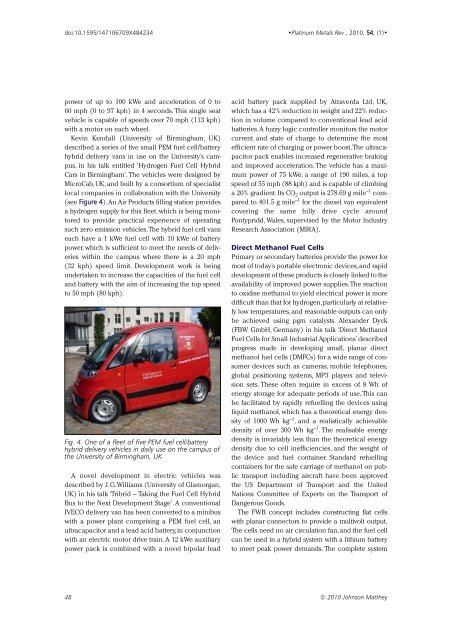Download Issue PDF - Platinum Metals Review
Download Issue PDF - Platinum Metals Review
Download Issue PDF - Platinum Metals Review
You also want an ePaper? Increase the reach of your titles
YUMPU automatically turns print PDFs into web optimized ePapers that Google loves.
doi:10.1595/147106709X484234<br />
•<strong>Platinum</strong> <strong>Metals</strong> Rev., 2010, 54, (1)•<br />
power of up to 100 kWe and acceleration of 0 to<br />
60 mph (0 to 97 kph) in 4 seconds. This single seat<br />
vehicle is capable of speeds over 70 mph (113 kph)<br />
with a motor on each wheel.<br />
Kevin Kendall (University of Birmingham, UK)<br />
described a series of five small PEM fuel cell/battery<br />
hybrid delivery vans in use on the University’s campus,<br />
in his talk entitled ‘Hydrogen Fuel Cell Hybrid<br />
Cars in Birmingham’. The vehicles were designed by<br />
MicroCab, UK, and built by a consortium of specialist<br />
local companies in collaboration with the University<br />
(see Figure 4).An Air Products filling station provides<br />
a hydrogen supply for this fleet, which is being monitored<br />
to provide practical experience of operating<br />
such zero emission vehicles.The hybrid fuel cell vans<br />
each have a 1 kWe fuel cell with 10 kWe of battery<br />
power, which is sufficient to meet the needs of deliveries<br />
within the campus where there is a 20 mph<br />
(32 kph) speed limit. Development work is being<br />
undertaken to increase the capacities of the fuel cell<br />
and battery with the aim of increasing the top speed<br />
to 50 mph (80 kph).<br />
Fig. 4. One of a fleet of five PEM fuel cell/battery<br />
hybrid delivery vehicles in daily use on the campus of<br />
the University of Birmingham, UK<br />
A novel development in electric vehicles was<br />
described by J. G.Williams (University of Glamorgan,<br />
UK) in his talk ‘Tribrid – Taking the Fuel Cell Hybrid<br />
Bus to the Next Development Stage’. A conventional<br />
IVECO delivery van has been converted to a minibus<br />
with a power plant comprising a PEM fuel cell, an<br />
ultracapacitor and a lead acid battery,in conjunction<br />
with an electric motor drive train.A 12 kWe auxiliary<br />
power pack is combined with a novel bipolar lead<br />
acid battery pack supplied by Atraverda Ltd, UK,<br />
which has a 42% reduction in weight and 22% reduction<br />
in volume compared to conventional lead acid<br />
batteries.A fuzzy logic controller monitors the motor<br />
current and state of charge to determine the most<br />
efficient rate of charging or power boost.The ultracapacitor<br />
pack enables increased regenerative braking<br />
and improved acceleration. The vehicle has a maximum<br />
power of 75 kWe, a range of 190 miles, a top<br />
speed of 55 mph (88 kph) and is capable of climbing<br />
a 20% gradient.Its CO 2 output is 278.69 g mile –1 compared<br />
to 401.5 g mile –1 for the diesel van equivalent<br />
covering the same hilly drive cycle around<br />
Pontypridd, Wales, supervised by the Motor Industry<br />
Research Association (MIRA).<br />
Direct Methanol Fuel Cells<br />
Primary or secondary batteries provide the power for<br />
most of today’s portable electronic devices,and rapid<br />
development of these products is closely linked to the<br />
availability of improved power supplies.The reaction<br />
to oxidise methanol to yield electrical power is more<br />
difficult than that for hydrogen,particularly at relatively<br />
low temperatures,and reasonable outputs can only<br />
be achieved using pgm catalysts. Alexander Dyck<br />
(FBW GmbH, Germany) in his talk ‘Direct Methanol<br />
Fuel Cells for Small Industrial Applications’ described<br />
progress made in developing small, planar direct<br />
methanol fuel cells (DMFCs) for a wide range of consumer<br />
devices such as cameras, mobile telephones,<br />
global positioning systems, MP3 players and television<br />
sets. These often require in excess of 8 Wh of<br />
energy storage for adequate periods of use. This can<br />
be facilitated by rapidly refuelling the devices using<br />
liquid methanol, which has a theoretical energy density<br />
of 1000 Wh kg –1 , and a realistically achievable<br />
density of over 300 Wh kg –1 . The realisable energy<br />
density is invariably less than the theoretical energy<br />
density due to cell inefficiencies, and the weight of<br />
the device and fuel container. Standard refuelling<br />
containers for the safe carriage of methanol on public<br />
transport including aircraft have been approved<br />
the US Department of Transport and the United<br />
Nations Committee of Experts on the Transport of<br />
Dangerous Goods.<br />
The FWB concept includes constructing flat cells<br />
with planar connectors to provide a multivolt output.<br />
The cells need no air circulation fan, and the fuel cell<br />
can be used in a hybrid system with a lithium battery<br />
to meet peak power demands. The complete system<br />
48 © 2010 Johnson Matthey
















